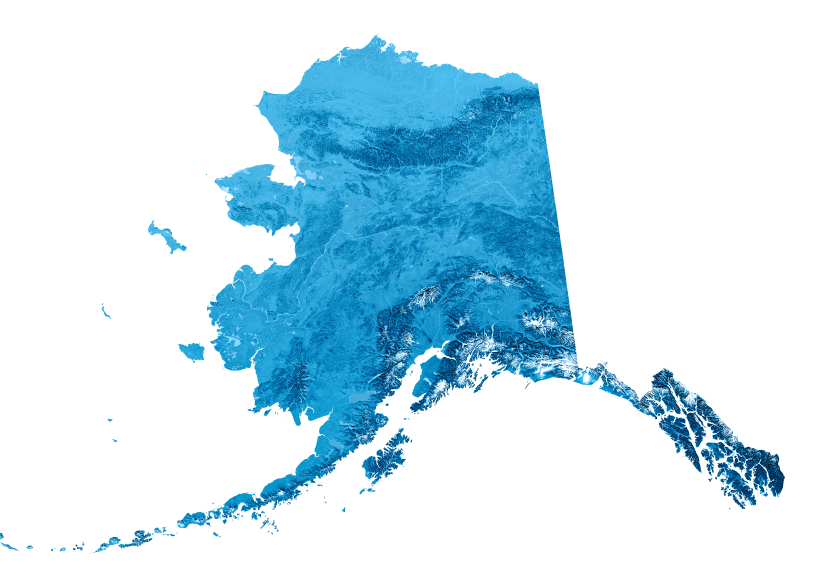Better technology stretches Arctic Alaska’s shrinking tundra travel season

A decade ago, oil operators on the North Slope found themselves in a climate predicament.
The steady warming seen since the late 1960s had cut the tundra travel season — the period when operators are able to build ice roads or send vehicles over the hard-frozen ground — by half, from about 200 days to only about 100.
Now, even though warming has continued and North Slope permafrost temperatures continue to rise, oil companies and land managers have halted the shrinkage of the tundra-travel season. Through some rule changes, application of technology and on-scene adaptations, they have even been able to regain some of the travel season lost to softening soils.
Fewer tundra travel days
This past winter, the Alaska Department of Natural Resources allowed 143 days of tundra travel for at least some portion of the North Slope. Though that fell short of the long tundra-travel seasons enjoyed by oil companies in the early days of North Slope oil development, it was the third-longest in the past 10 years, said Brian Jackson, a natural resource specialist with the North Slope team at DNR’s Division of Mining, Land and Water. The season for using the ice roads constructed on the tundra was even longer; at 213 days, it was the longest ice-road-travel season since the winter of 2003-04, according to DNR’s records.
“It wasn’t the coldest winter. But it was consistent, and it was cold enough,” Jackson said.
Making up for lost time
Travel over the fragile Arctic tundra, including construction of temporary ice roads that are crucial transportation links for explorers and developers, is allowed only when the ground is sufficiently frozen or snow-covered to protect it from damage that could be caused by heavy vehicles.
For the first three decades of oil operations, tundra travel was allowed by the state when there was at least 12 inches of frozen ground and 6 inches of snow cover, a standard that DNR managers admitted was based more on general experience than on any precise tests.
Under pressure from loss of travel time, which substantially compressed oil companies’ exploration and development seasons, the DNR launched a project in 2003 to learn specifically how much snow and frost was needed to protect the tundra. Researchers spent two seasons collecting data and performing experiments to pinpoint the resilience of snowpack and frozen ground.
Study results
The result was a set of more precise standards and rules for state lands on the North Slope. Those rules divide the North Slope, previously managed as a single unit for tundra-travel purposes, into four regions, according to terrain and vegetation types. In the flat western and eastern coastal regions, temperatures must be 23 degrees or colder in the top 12 inches of the soil, and there must be 6 inches of snow on the ground. In the lower and upper foothills, the 12-inch, 23-degree standard is the same, but there must be 9 inches of snow cover.
Those standards were based on two years of data collection and experiments testing resilience of snowpack and frost layers. It was the first empirical examination of the question, said Harry Bader, who oversaw the project as DNR’s northern regional land manager at the time.
Evaluating new standards
Bader is now examining data he collected when he returned in 2012 and 2013 to the North Slope test sites to verify whether the new standards have successfully protected the tundra.
In retrospect, not all of the tundra-travel reduction seen then was caused by a warming climate, said Bader, now an associate research professor at the University of Alaska Fairbanks and head of the university’s Polar Environmental Security Program.
A “good chunk” was attributable to disparate measuring systems and even inconsistent use of slide hammers and other devices, he said.
And not all aspects of future warming will necessarily be detrimental to tundra travel, Bader said. For example, If there is more snow, as predicted for high Arctic climates, that might be a help — unless the snow winds up insulating the ground before it freezes, he said.
Nonetheless, the warmer climate is a reality, and the old days of North Slope-wide tundra travel for the majority of the year are gone, Bader said.
“We’re not going to have a 1970s-style season, for a whole variety of reasons,” Bader said.
Regional delays
Indeed, this past season’s tundra-travel authorizations included some regional delays and omissions. While travel was opened in the two coastal zones on Dec. 19, the lower foothills region did not open until Feb. 20, and the upper foothills area never opened to tundra travel the entire winter, Jackson said. In that region, there was too much snow too early, insulating the soil and preventing sufficient freeze, he said.
Several companies operating on the North Slope have a low-tech way to fend off that insulation problem, at least in localized areas. When the snow flies, they compress it to remove the tiny air pockets that give it insulation qualities, Jackson said. The results are clear, and DNR managers are able to watch the soil temperatures drop after such snow packing, he said.
New app
There is a more high-tech travel aid: a UAF-created online app.
The mobile-friendly computerized program, designed by UAF’s Geographic Information Network of Alaska at DNR’s request, provides information about where operators are allowed to travel, when areas are open, when they are closed and other up-to-the-minute information.
The inputs come from the measurements of soil temperatures, snow depth and snow density made at DNR’s numerous North Slope monitoring stations. DNR managers on the North Slope can post data, and users can see the results in an online map, UAF said in a news release that touted the system.
Dayne Broderson, GINA’s technical services manager, said the app is appreciated by industry members who want rapid access to travel status in specific zones. Whether it is expanded depends on DNR, he said in an email.
“There has been a lot of excitement by a variety of people both at UAF and outside about the ability to bring together more data integrated and presented towards the goal of Tundra Travel. What direction that takes depends on DNR and if those with interest in additional capabilities can help us find the resources to implement new capabilities,” he said in the email.
Related stories from around the North:
Canada: The geometries of Arctic all-weather road construction, Blog by Mia Bennett
Norway: Norway delays bridge-building to Russia on road to Crimea, Barents Observer
Russia: Murmansk, Russia: Transport hub trouble, again, Barents Observer
United States: Plans to raise Arctic Alaska highway with 2 million tons of gravel, Alaska Dispatch News



